Alteryx Assessment Report
This topic contains information about the Alteryx assessment report. The input format for the Alteryx assessment is YXMD or YXZP.
In This Topic:
Highlights
The highlights section gives you a high-level overview of your assessment based on the analysis of the selected workloads. It includes a summary as well as the complexity and query details of the source input files.
Summary
This section summarizes the input Alteryx documents, including the number of documents, nodes, macros, and parsed documents.

- Total Alteryx Documents: Displays the total number of input source files.
- Nodes: Displays the number of components existing in the source files.
- Macros: Displays the number of macros.
- Parsed Documents: Displays the number of parsed Alteryx documents.
Queries
It displays a synopsis of the queries with information about parsed and unparsed queries as well as the complexity of queries.

Complexity
This section provides a summarized graphical representation of the complexity of the Alteryx documents that helps in making different decisions, including budget estimation.

Expressions
This section highlights the expressions existing in the source file.

- Function: Displays the number of functions that help to create expressions.
- Expression: Displays the number of expressions that are used to perform various transformations and calculations.
Analysis
This topic provides a detailed examination of source files, entities, and artifacts.
Source Analysis
This section provides a comprehensive report of the source files with information about the total number of files, nodes, macros, the complexity of files, and so on.

- File Name: Displays the name of the source files.
- Nodes: Displays the number of components existing in each source file.
- Macros: Displays the number of macros existing in each source file.
- AIML: Displays the number of components that belong to the AIML bucket. It helps to identify the complexity of files.
- NLP: Displays the number of components that belong to the NLP bucket. It helps to identify the complexity of files.
- Reporting: Displays the number of components that belong to the Reporting bucket. It helps to identify the complexity of files.
- SAS: Displays the number of components that belong to the SAS bucket. It helps to identify the complexity of files.
- Others: Displays the number of components other than components that belong to AIML, NLP, Reporting, or SAS buckets.
- Complexity: Displays the complexity of each file.
Entities
This section displays a detailed analysis of the entities. It provides in-depth insights into all the available tables and files.
Tables
The Table section provides details about the tables used in the source and target.

- Table Name: Lists the name of the tables.
- Frequency of Use: Provides the frequency of table usages.
- Source Database: Provides details of source database.
Files
The Files section provides details about the files used in the source and target.

- File Name: Lists the name of files.
- Frequency of Use: Provides the frequency of file usages.
Artifacts
This page gives you details about artifacts-collections of the related server data. It provides a list of missing artifacts.
Missing Artifacts
This section provides the details of all the missing artifacts. Additionally, this displays information about types and linkage of the artifacts.

- Artifact Name: Displays the name of the artifacts.
- Type: Provides the type of artifacts such as file, table.
- Linkage: Provides the linked or associated file names.
Lineage
End-to-end process lineage identify the complete dependency structure through interactive and drill-down options to the last level.
Typically, even within one line of business, multiple data sources, entry points, ETL tools, and orchestration mechanisms exist. Decoding this complex data web and translating it into a simple visual flow can be extremely challenging during large-scale modernization programs. The visual lineage graph adds tremendous value and helps define the roadmap to the modern data architecture. It deep dives into all the existing flows and provides integrated insights. These insights help data teams make strategic decisions with greater accuracy and completeness. Enterprises can proactively leverage integrated analysis to mitigate the risks associated with migration and avoid business disruption.

To view the required lineage, enter the keywords in the Search Keywords field and then click the Search icon.
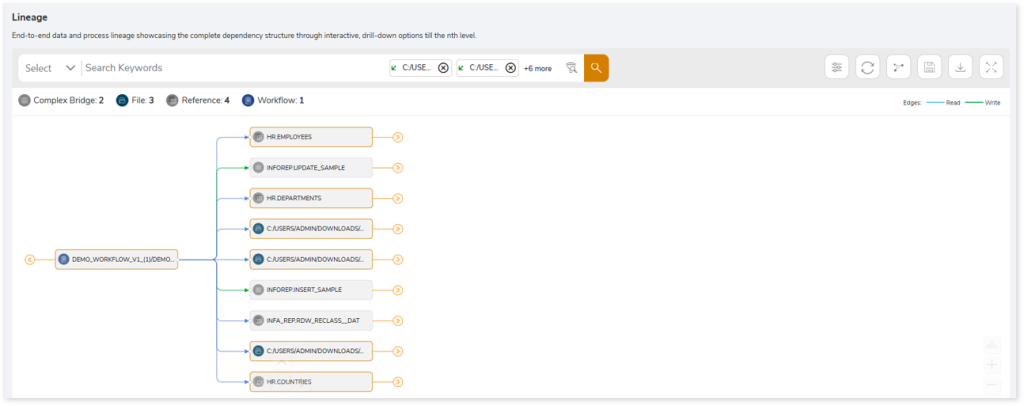
In addition, the filter search icon allows you to include or exclude particular nodes to obtain the required dependency structure. You can also choose the direction of the lineage. By default, the Dependency Direction is Left to Right Hierarchy. You can also choose Right to Left Hierarchy or Bidirectional dependency directions as required. Moreover, you can also increase the Hierarchy Levels to nth level.

Lineage facilitates you visualize how your selected nodes are connected and depend on each other. The nodes and their connecting edges (relationships) help you to understand the overall structure and dependencies.
|
Nodes |
Edges |
 Workflow Workflow |
 Read Read |
 File File |
 Write Write |
 Tables Tables |
 Call Call |
 Complex Bridge Complex Bridge |
 Others Others |
 Reference Reference |
|
Manage Lineage
This feature enables you to view and manage your lineage. You can add, modify, or delete nodes and their relationships to generate an accurate representation of the required dependency structure. There are two ways to update the lineage: either using Complete Lineage report or Lineage Template.
Using Complete Lineage report
Follow the below steps to modify the lineage:
- Click the Manage Graph icon.

- Click Download Complete Lineage to update, add, or delete the nodes and their relationships in the current lineage.

- Once the complete lineage report is downloaded, you can make necessary updates such as updating, deleting or adding the nodes and its relationships.
- After making the required changes, upload the updated lineage report in Upload to Modify Lineage.
- Click Apply to incorporate the updates into the dependency structure.
- Generate the required lineage.
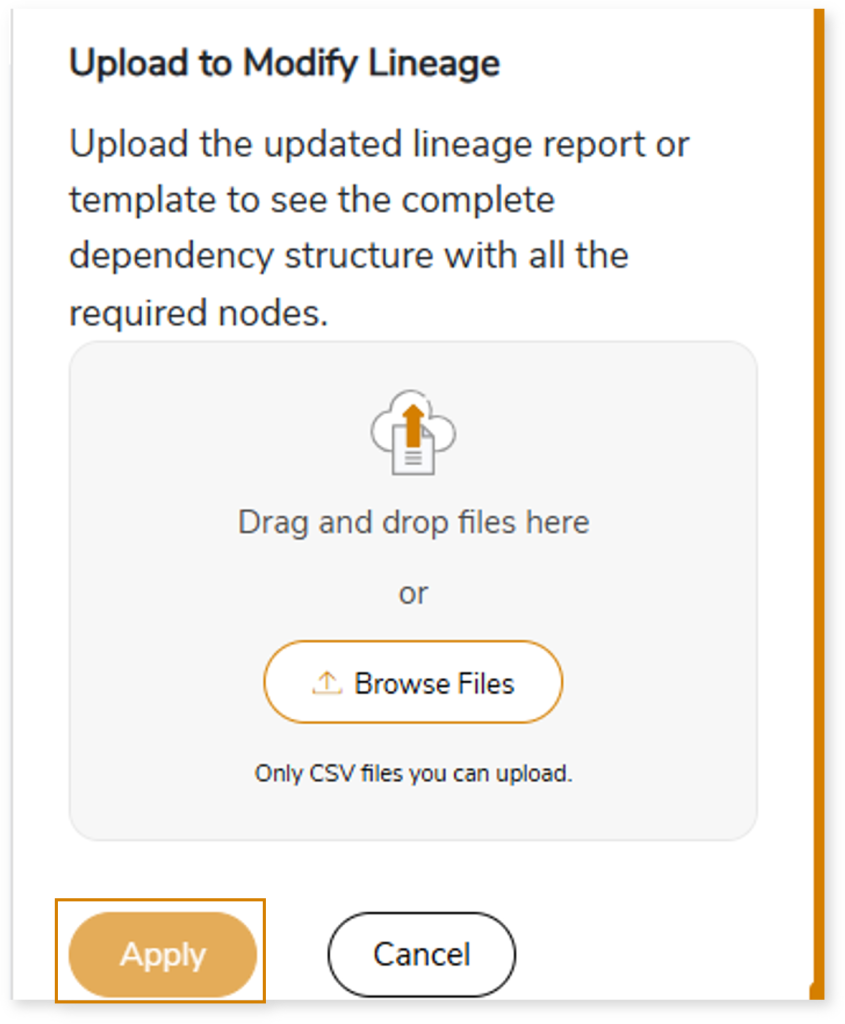
Using Lineage Template
Follow the below steps to add new nodes and their relationships to the current lineage report:
- Click the Manage Graph icon.

- Click Download Lineage Template.
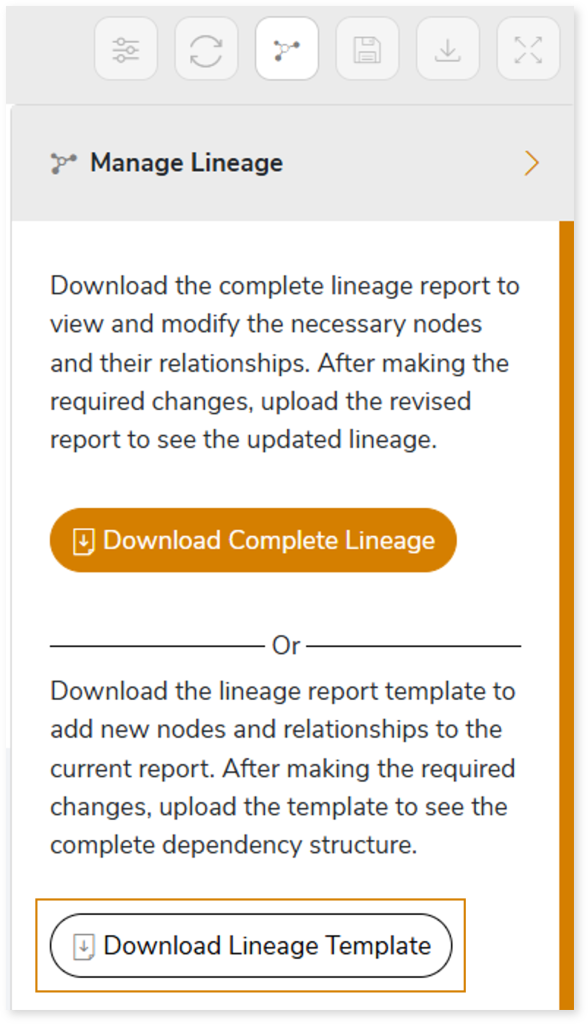
- Once the lineage template is downloaded, you can add new nodes and relationships in the template.
- After making the required changes, upload the template in Upload to Modify Lineage.
- Click Apply to incorporate the updates into the complete dependency structure.
- Generate the required lineage.

You can apply:
| Feature | Icon | Use |
| Filter |  | Used to filter the lineage. |
| Reload Graph |  | Assists in reloading graphs. |
| Manage Graph |  | To view and manage lineage by adding, modifying, or deleting nodes and their relationships to accurately reflect dependency structures. |
| Save |  | Used to save the lineage. |
| Download |  | Used to download the file. |
| Expand |  | Used to enlarge the screen. |
Downloadable Reports
Downloadable reports allow you to export detailed Alteryx assessment reports of your source data which enables you to gain in-depth insights with ease. To access these assessment reports, click Reports.

Types of Reports
In the Reports section, you can see various types of reports such as Insights and Recommendations, Source Inventory Analysis, and Lineage Report. Each report type offers detailed information allowing you to explore your assessment results.

Insights and Recommendations
This report provides an in-depth insight into the source input files. It contains the final output including information about workflows, nodes, expressions, macros, and more.
Here, you can see alteryx folder along with alteryx_report.xlsx report.

alteryx_report.xlsx: This report provides insights about the source inventory. It helps you plan the next frontier of a modern data platform methodically. It includes information about workflows, nodes, expressions, macros, and more.
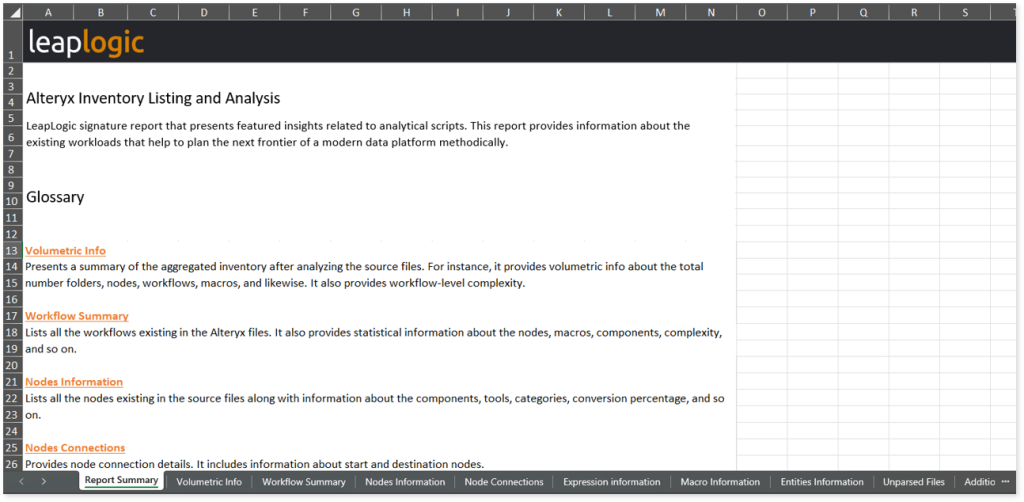
This report contains the following information:
- Report Summary: Provides information about all the generated artifacts.
- Volumetric Info: Presents a summary of the aggregated inventory after analyzing the source files. For instance, it provides total number of folders, nodes, workflows, macros, and likewise. It also provides workflow-level complexity.
- Workflow Summary: Lists all the workflows existing in the Alteryx files. It also provides statistical information about the nodes, macros, components, complexity, and so on.
- Nodes Information: Lists all the nodes existing in the source files along with information about the components, tools, categories, conversion percentage, and so on.
- Nodes Connections: Provides node connection details. It includes information about start and destination nodes.
- Expression information: Lists all the expressions in the source files along with the expression functions.
- Macro Information: Lists all the macros existing in the input source files along with their status.
- Entities Information: Lists all the entities along with their type such as Tables or Views. It also provides information about the tables used, database types, and so on.
- Unparsed Files: Lists all the Alteryx files that are not parsed.
- Additional file: Lists all the Alteryx files that appear additionally.
- Expression Functions: Lists all the functions along with the frequency of use.
- Queries Information: Lists all the queries existing in the source files. It also provides information about the file types, complexity of queries, and query analysis status.
- Constants Information: Provides information about the constants along with their value and namespace existing in the source files.
- Missing Files: Lists all the missing source files along with components and tools.
- Database: Lists all databases.
Browse through alteryx folder to access alteryx_database_info.csv, alteryx_expression_functions_information.csv, alteryx_macro_information.csv, alteryx_missing_files.csv, alteryx_query_information.csv, and alteryx_summary_information.csv reports.

alteryx_database_info.csv: This report provides information about databases.
alteryx_expression_functions_information.csv: This report provides information about all the functions along with their frequency.
alteryx_macro_information.csv: This report provides information about macros in the source file.

alteryx_missing_files.csv: This report provides information about missing files.
alteryx_query_information.csv: This report provides information about queries including file types, complexity, parse types, and more. If the analyzed status is TRUE, it indicates that the query is analyzed successfully. Conversely, a FALSE status indicates that the query is not analyzed.

alteryx_summary_information.csv: This report provides information about the Alteryx source input files. It includes information about the nodes, macros, expressions, complexity, and more.

Source Inventory Analysis
It is an intermediate report which helps to debug failures or calculate the final report. It includes all the generated CSV reports such as alteryx_additional_files.csv, alteryx_contants_information, alteryx_entity_information.csv, alteryx_node_connections.csv, alteryx_nodes_expression.csv, alteryx_nodes_information.csv, and alteryx_unparsed_files.csv.

alteryx_additional_files.csv: This report provides information about additional files along with their file path and message.
alteryx_contants_information: This report provides information about constants.
alteryx_entity_information.csv: This report provides information about entities such as tables and files. It includes details about databases, database types, and so on.
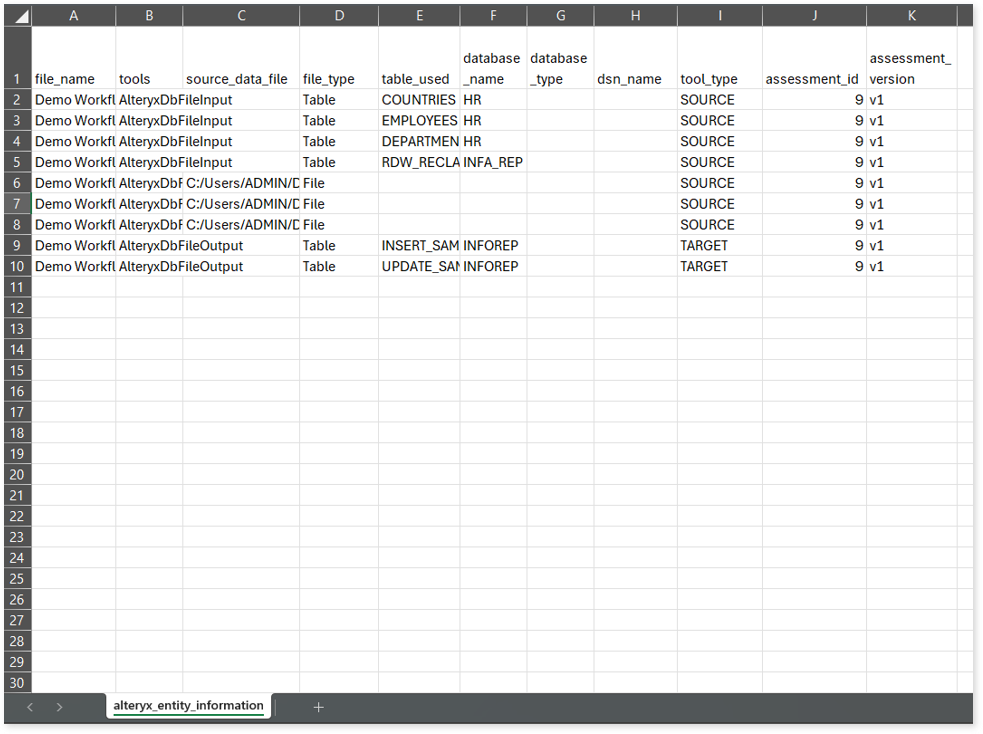
alteryx_node_connections.csv: This report provides information about nodes along with their origin and destination nodes.

alteryx_nodes_expression.csv: This report provides information about nodes along with its expressions. It also includes information about functions, tools, validity status of expressions, and more.
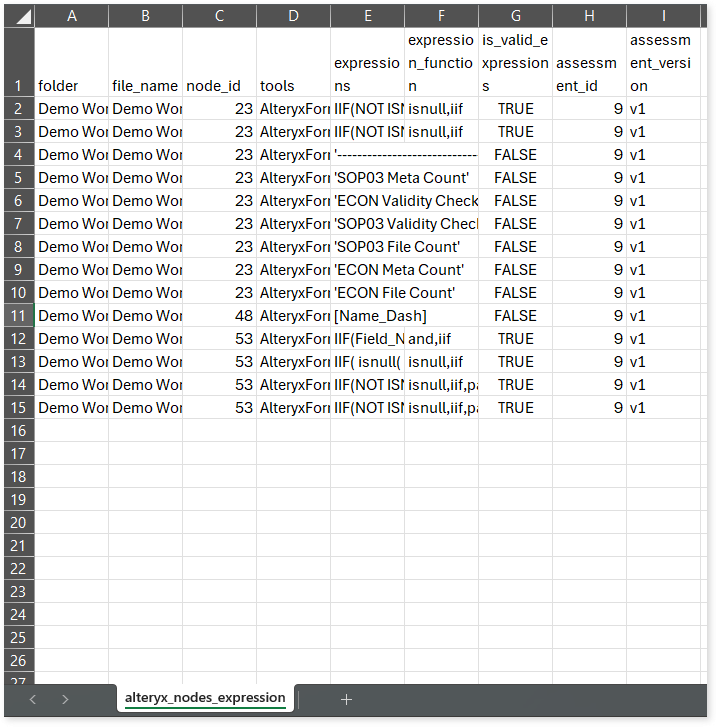
alteryx_nodes_information.csv: This report provides information about nodes including components, category types, macros, conversion percentage, and more.
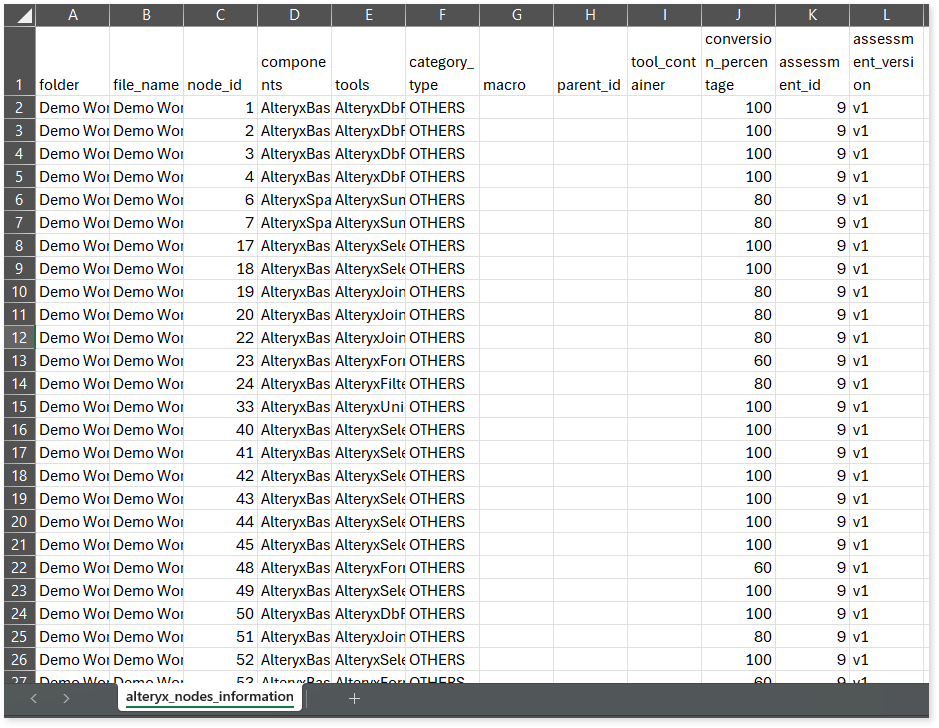
alteryx_unparsed_files.csv: This report lists all the unparsed files along with the reason for parsing failure.
Lineage Report
This report provides complete dependency details for all nodes. It provides an end-to-end data and process lineage that helps to identify the complete dependency structure and the data flow.

This report contains the following information:
- Volumetric Info: Provides volumetric information about the artifact types such as Alteryx workflows, tables, and files.
- Nodes: Lists all the source and target nodes along with its type.
- Dependency (Process): Provides information about the process lineage.
- Dependency (Data): Provides information about the data lineage.
- Dependency (Data Model): Provides dependency details about the data models.